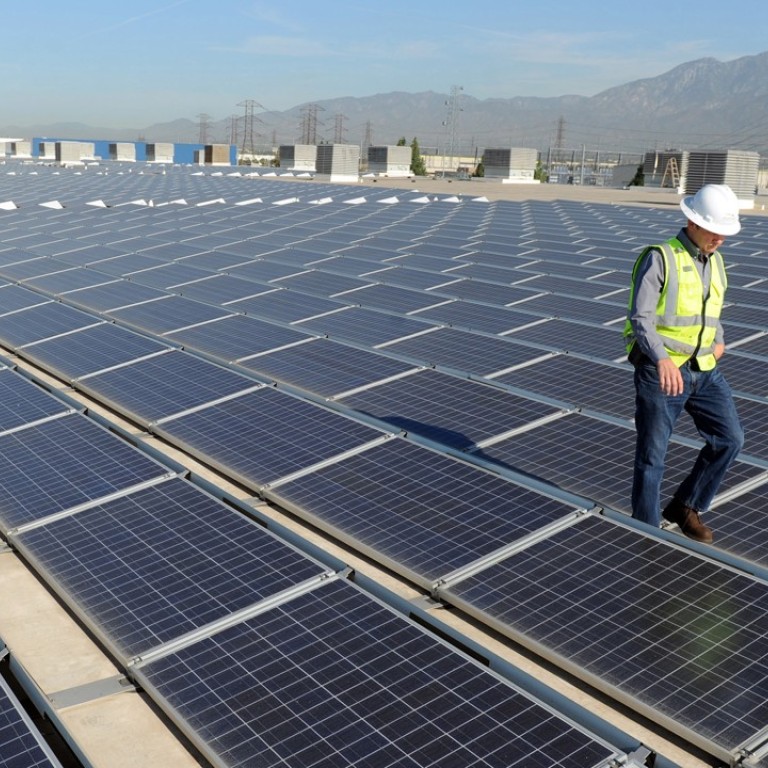
Why is this Chinese solar firm resisting pressure to set up shop in the US despite punitive tariffs?
Gao Jifan, chairman of Trina Solar, says it does not make economic sense to build a plant in the US as there are plenty of challenges and uncertainties
Setting up a plant in the US to get around the 30 per cent punitive tariff imposed on Chinese solar panels by the Trump administration does not make economic sense because of cost concerns and policy uncertainty, according to the chairman of Trina Solar, the world’s second largest solar panels maker.
“The US’ tariff on solar imports from the rest of the world is certainly a negative development for the industry,” Gao Jifan said in an interview on the sidelines of the Boao Forum for Asia on Tuesday. “But the economics of setting up a plant in the US as a result is not straightforward … there are plenty of challenges and uncertainties.
“It is possible that the plant may not be competitive by the time it is built.”
The Chinese solar manufacturing industry – which last year accounted for 55 to 83 per cent of global supply of products ranging from the raw material polysilicon to solar panels – has been hit by a 30 per cent punitive tariff announced in January.
Gao noted the tariff will fall by 5 percentage points per year for the five-year period of implementation, which reduces the incentive of setting a plant in the US.
Besides, it takes time to build a plant in the US, which will also be more expensive than elsewhere given the need to also establish a supply chain of peripheral materials such as aluminium extrusion products, he added.
Gao’s comment came close on the heels of rival Jinko Solar’s announcement late last month to build a factory in Florida to supply NextEra Energy with up to 2.75 gigawatt of panels over four years.
It was the first Chinese firm to announce a large-scale production facility in response to the US tariff.

A Credit Suisse report said the plant takes advantage of a 2.5GW a year solar cell quota exempted from tariffs under the US trade action. Cells are used to make panels.
The report said it makes sense near term as the US-made panels will cost between 5 and 15 per cent less compared to imported panels under tariffs announced through 2021.
Changzhou, Jiangsu province-based Trina has in the past five years set up plants in Vietnam – where it has built the nation’s largest plant for solar cells – Thailand, Malaysia and Holland to help get around tariffs from Europe and the US.
The US’ tariff on solar imports from the rest of the world is certainly a negative development for the industry
“Setting up a plant is a long-term matter that takes five to seven years … our plants in Thailand and Vietnam will have competitive advantages regardless of international trade policies,” Gao said.
He said there will be uncertainties as to how long trade restrictions will be maintained in the US and elsewhere, as the European Union has recently cancelled its quotas and tariffs on Chinese panels.
“The EU found out that the restrictive measures did not bring much impact to save the domestic companies which continued to go bankrupt due to competitive issues,” he said. “Also, higher priced panels saw the EU market shrink from 8GW to 6GW.”
Gao said India, which was mulling a 70 per cent tariff on Chinese panels, had recently decided against it.
Trina had bought land in India and planned to build a plant there, but pulled out after finding that extremely low solar farm tariffs and higher production costs compared to China meant “timing for a plant there is not mature”.
Trina, which delisted from the New York Stock Exchange last year, has been preparing for domestic listing in the mainland. Gao declined to comment on its progress.
The company shipped just over 9GW of panels last year, ranking it number two globally. By accumulated shipments of 32GW since its inception, it ranked first, Gao said.
But he said Trina is no longer seeking scale expansion as a priority, as it believes more profits can be made by offering hardware and software to enable solar farm developers to enhance profitability through the installation of systems to allow “smarter” green energy generation, distribution and consumption.

